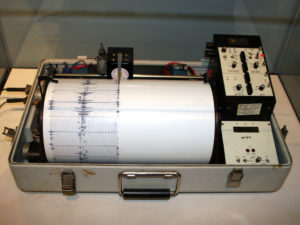Introduction
Why learn about exponential and logarithmic equations?
Joan enjoyed talking to her grandfather so much, that the next Sunday, she made sure she she would be there when he came to dinner. This time, though, she prepared a question for her grandfather. She had been learning about logarithmic and exponential functions in her math class and wanted to see if she could stump her grandfather with a math question. Kinemetrics Seismograph formerly used by the United States Department of the Interior.
Kinemetrics Seismograph formerly used by the United States Department of the Interior.[latex]R=\mathrm{log}\left(\frac{A}{A_{0}}\right)[/latex]
The question provided her with the quantity [latex]\frac{A}{A_{0}}[/latex] and asked her to solve for R. [latex]{A_{0}}[/latex] is a baseline measure of ground movement as detected by a seismometer, seen in the image above. When there is an earthquake, wave amplitudes recorded by seismometers are expressed relative to this baseline. For example, Joan's book asked the following question:
Joan hoped to give her grandfather the Richter scale magnitude for the Alaska quake, 8.5, and see if he could find how much greater the wave amplitude of that quake was than the baseline, [latex]{A_{0}}[/latex].
In this module you will learn how to solve problems such as the one Joan is planning to try to stump her grandfather with. We will come back to Joan and her grandfather at the end of this module to see if she was able to ask him a question he didn't know how to answer.
In this module, you will learn about the properties of exponential and logarithmic functions in the same way that you learned about the properties of exponents. You will use the properties of logarithms and exponentials to solve equations that involve them.
The learning outcomes for this module include:
- Define and use the properties of logarithms to expand, condense and change the base of a logarithmic expression.
- Use the properties of logarithms and exponentials to solve equations

